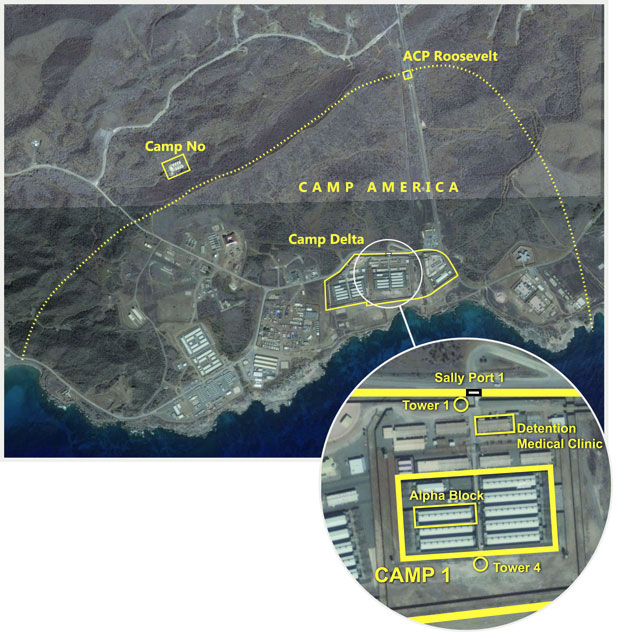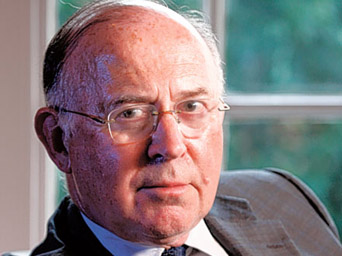Related information:
– Former UK ambassador: CIA sent people to Uzbekistan for extreme torture, to be ‘raped with broken bottles,’ ‘boiled alive’ and ‘having their children tortured in front of them’
Satellite photograph from Terraserver. (Click on image to enlarge.)


This is the full text of an exclusive advance feature by Scott Horton that will appear in the March 2010 Harper’s Magazine. The issue will be available on newsstands the week of February 15.
1. “Asymmetrical Warfare”
When President Barack Obama took office last year, he promised to “restore the standards of due process and the core constitutional values that have made this country great.” Toward that end, the president issued an executive order declaring that the extra-constitutional prison camp at Guantánamo “shall be closed as soon as practicable, and no later than one year from the date of this order.” Obama has failed to fulfill his promise. Some prisoners are being charged with crimes, others released, but the date for closing the camp seems to recede steadily into the future. Furthermore, new evidence now emerging may entangle Obama’s young administration with crimes that occurred during the Bush presidency, evidence that suggests the current administration failed to investigate seriously—and may even have continued—a cover-up of the possible homicides of three prisoners at Guantánamo in 2006.
Late in the evening on June 9 that year, three prisoners at Guantánamo died suddenly and violently. Salah Ahmed Al-Salami, from Yemen, was thirty-seven. Mani Shaman Al-Utaybi, from Saudi Arabia, was thirty. Yasser Talal Al-Zahrani, also from Saudi Arabia, was twenty-two, and had been imprisoned at Guantánamo since he was captured at the age of seventeen. None of the men had been charged with a crime, though all three had been engaged in hunger strikes to protest the conditions of their imprisonment. They were being held in a cell block, known as Alpha Block, reserved for particularly troublesome or high-value prisoners.
As news of the deaths emerged the following day, the camp quickly went into lockdown. The authorities ordered nearly all the reporters at Guantánamo to leave and those en route to turn back. The commander at Guantánamo, Rear Admiral Harry Harris, then declared the deaths “suicides.” In an unusual move, he also used the announcement to attack the dead men. “I believe this was not an act of desperation,” he said, “but an act of asymmetrical warfare waged against us.” Reporters accepted the official account, and even lawyers for the prisoners appeared to believe that they had killed themselves. Only the prisoners’ families in Saudi Arabia and Yemen rejected the notion.
Two years later, the U.S. Naval Criminal Investigative Service, which has primary investigative jurisdiction within the naval base, issued a report supporting the account originally advanced by Harris, now a vice-admiral in command of the Sixth Fleet. The Pentagon declined to make the NCIS report public, and only when pressed with Freedom of Information Act demands did it disclose parts of the report, some 1,700 pages of documents so heavily redacted as to be nearly incomprehensible. The NCIS report was carefully cross-referenced and deciphered by students and faculty at the law school of Seton Hall University in New Jersey, and their findings, released in November 2009, made clear why the Pentagon had been unwilling to make its conclusions public. The official story of the prisoners’ deaths was full of unacknowledged contradictions, and the centerpiece of the report—a reconstruction of the events—was simply unbelievable.
According to the NCIS, each prisoner had fashioned a noose from torn sheets and T-shirts and tied it to the top of his cell’s eight-foot-high steel-mesh wall. Each prisoner was able somehow to bind his own hands, and, in at least one case, his own feet, then stuff more rags deep down into his own throat. We are then asked to believe that each prisoner, even as he was choking on those rags, climbed up on his washbasin, slipped his head through the noose, tightened it, and leapt from the washbasin to hang until he asphyxiated. The NCIS report also proposes that the three prisoners, who were held in non-adjoining cells, carried out each of these actions almost simultaneously.
Al-Zahrani, according to the report, was discovered first, at 12:39 a.m., and taken by several Alpha Block guards to the camp’s detention medical clinic. No doctors could be found there, nor the phone number for one, so a clinic staffer dialed 911. During this time, other guards discovered Al-Utaybi. Still others discovered Al-Salami a few minutes later. Although rigor mortis had already set in—indicating that the men had been dead for at least two hours—the NCIS report claims that an unnamed medical officer attempted to resuscitate one of the men, and, in attempting to pry open his jaw, broke his teeth.
The fact that at least two of the prisoners also had cloth masks affixed to their faces, presumably to prevent the expulsion of the rags from their mouths, went unremarked by the NCIS, as did the fact that standard operating procedure at Camp Delta required the Navy guards on duty after midnight to “conduct a visual search” of each cell and detainee every ten minutes. The report claimed that the prisoners had hung sheets or blankets to hide their activities and shaped more sheets and pillows to look like bodies sleeping in their beds, but it did not explain where they were able to acquire so much fabric beyond their tightly controlled allotment, or why the Navy guards would allow such an obvious and immediately observable deviation from permitted behavior. Nor did the report explain how the dead men managed to hang undetected for more than two hours or why the Navy guards on duty, having for whatever reason so grievously failed in their duties, were never disciplined.
A separate report, the result of an “informal investigation” initiated by Admiral Harris, found that standard operating procedures were violated that night but concluded that disciplinary action was not warranted because of the “generally permissive environment” of the cell block and the numerous “concessions” that had been made with regard to the prisoners’ comfort, which “concessions” had resulted in a “general confusion by the guard and the JDG staff over many of the rules that applied to the guard force’s handling of the detainees.” According to Harris, even had standard operating procedures been followed, “it is possible that the detainees could have successfully committed suicide anyway.”
This is the official story, adopted by NCIS and Guantánamo command and reiterated by the Justice Department in formal pleadings, by the Defense Department in briefings and press releases, and by the State Department. Now four members of the Military Intelligence unit assigned to guard Camp Delta, including a decorated non-commissioned Army officer who was on duty as sergeant of the guard the night of June 9–10, have furnished an account dramatically at odds with the NCIS report—a report for which they were neither interviewed nor approached.
All four soldiers say they were ordered by their commanding officer not to speak out, and all four soldiers provide evidence that authorities initiated a cover-up within hours of the prisoners’ deaths. Army Staff Sergeant Joseph Hickman and men under his supervision have disclosed evidence in interviews with Harper’s Magazine that strongly suggests that the three prisoners who died on June 9 had been transported to another location prior to their deaths. The guards’ accounts also reveal the existence of a previously unreported black site at Guantánamo where the deaths, or at least the events that led directly to the deaths, most likely occurred.
2. “Camp No”
The soldiers of the Maryland-based 629th Military Intelligence Battalion arrived at Guantánamo Naval Base in March 2006, assigned to provide security to Camp America, the sector of the base containing the five individual prison compounds that house the prisoners. Camp Delta was at the time the largest of these compounds, and within its walls were four smaller camps, numbered 1 through 4, which in turn were divided into cell blocks. Life at Camp America, as at all prisons, was and remains rigorously routinized for both prisoners and their jailers. Navy guards patrol the cell blocks and Army personnel control the exterior areas of the camp. All observed incidents must be logged. For the Army guards who man the towers and “sally ports” (access points), knowing who enters and leaves the camp, and exactly when, is the essence of their mission.
One of the new guards who arrived that March was Joe Hickman, then a sergeant. Hickman grew up in Baltimore and joined the Marines in 1983, at the age of nineteen. When I interviewed him in January at his home in Wisconsin, he told me he had been inspired to enlist by Ronald Reagan, “the greatest president we’ve ever had.” He worked in a military intelligence unit and was eventually tapped for Reagan’s Presidential Guard detail, an assignment reserved for model soldiers. When his four years were up, Hickman returned home, where he worked a series of security jobs-prison transport, executive protection, and eventually private investigations. After September 11 he decided to re-enlist, at thirty-seven, this time in the Army National Guard.
Hickman deployed to Guantánamo with his friend Specialist Tony Davila, who grew up outside Washington, D.C., and who had himself been a private investigator. When they arrived at Camp Delta, Davila told me, soldiers from the California National Guard unit they were relieving introduced him to some of the curiosities of the base. The most noteworthy of these was an unnamed and officially unacknowledged compound nestled out of sight between two plateaus about a mile north of Camp Delta, just outside Camp America’s perimeter. One day, while on foot patrol, Hickman and Davila came across the compound. It looked like other camps within Camp America, Davila said, only it had no guard towers and it was surrounded with concertina wire. They saw no activity, but Hickman guessed the place could house as many as eighty prisoners. One part of the compound, he said, had the same appearance as the interrogation centers at other prison camps.
The compound was not visible from the main road, and the access road was chained off. The Guardsman who told Davila about the compound had said, “This place does not exist,” and Hickman, who was frequently put in charge of security for all of Camp America, was not briefed about the site. Nevertheless, Davila said, other soldiers-many of whom were required to patrol the outside perimeter of Camp America-had seen the compound, and many speculated about its purpose. One theory was that it was being used by some of the non-uniformed government personnel who frequently showed up in the camps and were widely thought to be CIA agents.
A friend of Hickman’s had nicknamed the compound “Camp No,” the idea being that anyone who asked if it existed would be told, “No, it doesn’t.” He and Davila made a point of stopping by whenever they had the chance; once, Hickman said, he heard a “series of screams” from within the compound.
Read moreThe Guantánamo ‘Suicides’: A Camp Delta sergeant blows the whistle








